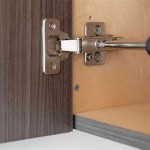What Is The Standard Kitchen Trash Can Size?
Determining the "standard" kitchen trash can size is not as simple as identifying a single, universally accepted dimension. The reality is that a multitude of factors influence the ideal trash can size for a particular kitchen, including household size, cooking frequency, available space, and personal preferences. Instead of a single standard, there exists a range of common sizes, each suited for different needs and circumstances. Understanding these sizes and the factors that inform their suitability is crucial for selecting a trash can that effectively manages waste while integrating seamlessly into the kitchen environment.
Kitchen trash cans serve as essential tools for maintaining cleanliness and hygiene. They collect food scraps, packaging materials, and other refuse generated during meal preparation and consumption. Choosing the right size is paramount for preventing overflowing, minimizing odors, and ensuring efficient waste disposal. A trash can that is too small requires frequent emptying, leading to inconvenience and potential messes. Conversely, a trash can that is too large may take up valuable floor space and contribute to unpleasant smells as waste accumulates over time.
The following sections will explore the typical size ranges for kitchen trash cans, delve into the factors that determine the most appropriate size for a given household, and discuss different types of trash cans and their corresponding dimensions.
Common Kitchen Trash Can Sizes: A Range to Consider
While there is no single "standard" size, certain capacity ranges are more prevalent than others when it comes to kitchen trash cans. These sizes effectively cater to the needs of most households, balancing capacity with spatial considerations. It is important to note that capacity is generally measured in gallons or liters.
Small (5-10 Gallons): These compact trash cans are typically suitable for individuals or small households with limited waste generation. They are often used in apartments, studios, or as supplemental trash cans in larger kitchens. They are useful for collecting specific types of waste, such as recyclable materials or food scraps destined for composting. Their smaller size necessitates more frequent emptying, but they are easily maneuverable and take up minimal floor space.
Medium (11-16 Gallons): This size range represents a common and versatile option for many households. They adequately accommodate the waste produced by families of two to four people, especially those who cook regularly. These trash cans offer a good balance between capacity and size, often fitting comfortably under a countertop or in a designated trash cabinet. They strike a reasonable compromise regarding emptying frequency, typically requiring disposal every few days.
Large (17-20 Gallons): Larger trash cans are best suited for larger families or households that generate a significant amount of waste. Frequent home cooking, entertaining guests, and a focus on reducing trips to the curb can all contribute to the need for a larger capacity. These trash cans require more dedicated space and can be cumbersome to move when full. However, they minimize the frequency of emptying, which is advantageous for busy individuals or those who prefer less frequent waste disposal.
Extra Large (20+ Gallons): These are typically commercial-grade trash cans and are less common in residential kitchens. They are appropriate for very large families or situations where waste generation is exceptionally high. They demand substantial space and can be quite heavy when full. Their primary advantage is the extended intervals between emptying, but their size and weight can present logistical challenges.
Factors Influencing the Ideal Trash Can Size
Determining the appropriate trash can size for a kitchen involves considering a variety of factors specific to the household's needs and circumstances. These factors should be carefully evaluated to ensure that the chosen trash can effectively manages waste without creating inconveniences or compromising kitchen aesthetics.
Household Size: The number of occupants in a household is a primary determinant of waste generation. Larger households naturally produce more waste, necessitating a larger trash can capacity. Single individuals or couples may find a small or medium-sized trash can sufficient, while families with children typically require a medium or large-sized option.
Cooking Frequency: Households that cook frequently tend to generate more food scraps and packaging materials compared to those who rely heavily on takeout or pre-prepared meals. Regular home cooking often necessitates a larger trash can to accommodate the increased waste volume. Consider the types of meals prepared and the amount of packaging involved. If significant effort is put into minimizing packaging waste, such as buying in bulk or using reusable containers, the need for a larger trash can may be reduced.
Available Space: The physical dimensions of the kitchen and the available space for a trash can are crucial constraints. Before purchasing a trash can, accurately measure the designated area, taking into account any obstructions or limitations. Consider whether the trash can will be placed under a countertop, inside a cabinet, or in an open area. Select a trash can size that comfortably fits within the available space without impeding movement or access to other kitchen elements.
Waste Disposal Habits: The frequency with which waste is disposed of also influences the optimal trash can size. If waste is taken out daily or every other day, a smaller trash can may suffice. However, if waste disposal occurs less frequently, a larger trash can is necessary to accommodate the accumulated volume. Factors such as local waste collection schedules and personal preferences regarding odor management should be considered. Some individuals prefer to empty their trash can more frequently to minimize odors, even if the can is not completely full.
Recycling and Composting Practices: The extent to which a household engages in recycling and composting significantly impacts the amount of waste that ends up in the kitchen trash can. If recyclables and compostable materials are diligently separated, the volume of general waste will be reduced, potentially allowing for a smaller trash can size. Conversely, households that do not actively recycle or compost will require a larger trash can to accommodate all types of waste.
Type of Waste Generated: The nature of the waste produced in the kitchen can also influence the ideal trash can size. Households that frequently dispose of bulky items, such as cardboard boxes or large food packaging, may benefit from a larger trash can. Conversely, households that primarily generate smaller items, such as food scraps and paper towels, may find a smaller trash can adequate.
Types of Trash Cans and Their Dimensions
The type of trash can also plays a role in determining the overall size and shape. Different types of trash cans are designed with varying features and functionalities, which can affect their dimensions and capacity.
Step-On Trash Cans: Step-on trash cans allow for hands-free operation, which is particularly beneficial in a kitchen environment. They typically feature a hinged lid that is opened by pressing a foot pedal. Step-on trash cans are available in various sizes, ranging from small countertop models to larger freestanding units. Their height can vary significantly depending on the capacity and design.
Touchless Trash Cans: Touchless trash cans utilize infrared sensors to detect motion and automatically open the lid. These trash cans are hygienic and convenient, as they eliminate the need to physically touch the can. Touchless trash cans are commonly powered by batteries or AC adapters. Like step-on cans, they come in a range of sizes and heights.
Pull-Out Trash Cans: Pull-out trash cans are designed to be installed inside a kitchen cabinet, providing a concealed and space-saving solution. These trash cans typically consist of a frame that slides out on rails, allowing for easy access to the trash container. Pull-out trash cans are available in various sizes to fit different cabinet dimensions. Their capacity is often determined by the cabinet's width and depth.
Swing-Top Trash Cans: Swing-top trash cans feature a lid that pivots or swings open, allowing for easy disposal of waste. These trash cans are simple and affordable, but they may not be as hygienic as step-on or touchless models since the lid is frequently touched. Swing-top trash cans are available in different sizes and styles.
Recycling Bins: Recycling bins are specifically designed for collecting recyclable materials, such as paper, plastic, and glass. They often feature separate compartments or color-coded lids to facilitate sorting. Recycling bins are available in various sizes and configurations, depending on the types of materials being recycled and the available space.
When considering the dimensions of a trash can, it is essential to take into account not only its capacity but also its overall footprint. The height, width, and depth of the trash can should be carefully measured to ensure that it fits comfortably within the designated space and does not obstruct movement or access to other kitchen elements.

What Size Trash Can Is Right For Your Home Kitchen Cans Unlimited

What Size Trash Can Is Right For Your Home Kitchen Cans Unlimited

Ultimate Guide To Select Standard Kitchen Trash Can Size

Qualiazero 20 Gallon Trash Can Stainless Steel Step On Kitchen Com

Mics Kitchen Trash 13 2 Gallons 50l Garbage Can Pedal Rubbish Bin With Plastic Inner Bucket Brown Com

Qualiazero 13 2 Gallon Trash Can Rectangular Step On Kitchen Silver Com

Innovaze 15 85 Gallon Trash Can Motion Sensor Touchless Kitchen Stainless Steel Com

Standard Trash Can Dimensions With Drawings Upgradedhome Com

Eko Madison Brushed Stainless Steel 13 2 Gallon Step Trash Can Fingerprint Resistant Kitchen Com

What Size Is A Kitchen Trash Can Ultimate Guide
Related Posts








